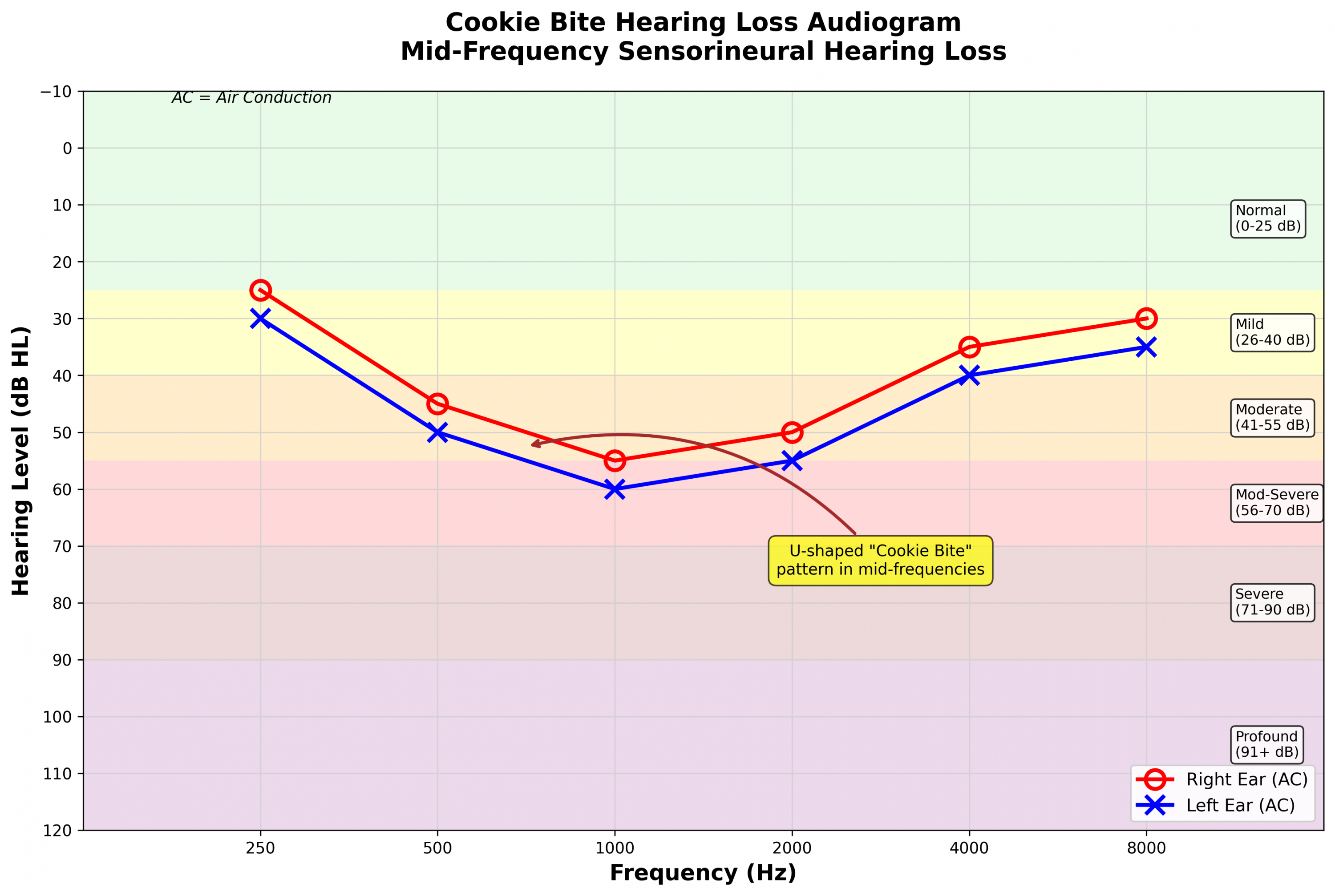
Head of Online Medical Content

Audiology Expert

What is Cookie Bite Hearing Loss?
The causes, risks, symptoms and treatments
Overview | What is it? | Getting diagnosed | What can help? | Conclusion
Last Hearing Aid UK Update:
Overview
Cookie bite hearing loss is a rare type of hearing loss that affects mid-range sounds, making speech harder to follow, especially in noisy settings.
Often genetic and progressive, it’s diagnosed through a hearing test showing a U-shaped audiogram. Specially tuned hearing aids can help improve clarity and quality of life.
The less-common hearing loss
Hearing loss comes in many shapes and forms, and one of the lesser-known types is cookie bite hearing loss. It might sound like a quirky name for a medical condition, but it refers to a very real, and often quite frustrating, hearing issue that affects thousands across the UK.
So, what exactly is cookie bite hearing loss, and how does it impact daily life? Let’s take a look to see if this might sound familiar.
What is it?
Cookie bite hearing loss (also known as U-shaped hearing loss) is a type of sensorineural hearing loss that affects the mid-range frequencies, roughly the pitch range of human speech.
If you imagine plotting your hearing levels on a graph, called an audiogram, it would dip in the middle – hence the term cookie bite, as if someone has taken a chomp out of the curve.
It’s often genetic and can be progressive, meaning it tends to worsen over time. Many people don’t realise they have it until their 20s, 30s, or even later, since it can develop gradually.
Unlike high-frequency hearing loss, cookie bite hearing loss affects the ability to hear voices clearly, particularly when there’s background noise.
Related reading: Sensorineural hearing loss

What is it like?
To understand how cookie bite hearing loss affects people day to day, here are a few examples:
- At work: In meetings, hearing loss can turn simple discussions into a guessing game. While deeper or higher-pitched voices might come through clearly, mid-range voices often fade away, making it easy to miss key points.
You may find yourself nodding along or asking people to repeat themselves, which gets tiring over time.
- At events: Social settings like pubs or restaurants are no easier. Background noise, clinking glasses and mixes of different chatter make it difficult to follow conversations.
You might catch parts of a story but miss the important bits, especially when someone speaks in that tricky mid-range.
- At home: Even at home, chatting with kids can be tough. Their voices often fall right in the range you find most challenging, and if they mumble or speak quickly, it’s even harder to follow.
You’re not ignoring them; it’s just genuinely difficult to hear them clearly, which can lead to frustration on both sides.
Getting diagnosed with cookie bite hearing loss
Because cookie bite hearing loss isn’t as obvious as other types, many people go undiagnosed for years. They might simply think others are mumbling or that their hearing is not quite what it used to be.
A professional hearing test – conducted by an audiologist – is the only way to confirm cookie bite hearing loss. The audiogram will clearly show that U-shaped curve, which helps highlight the issue.
It's worth doing, even if you’re just slightly suspicious – early detection can really improve your quality of life.
What can help?
The go-to treatment for cookie bite hearing loss is often hearing aids, specifically tuned to amplify those mid-range frequencies without over-boosting the highs and lows. Modern hearing aids are remarkably discreet and clever.
Many now include smart technology that adjusts in real-time depending on your environment. Some even connect to your phone or TV, making life that little bit easier.
It's also important to let those around you know what's going on. Whether it's asking to sit at the quieter end of the pub or requesting subtitles for a film night, small changes can make a big difference.
Related reading: Hearing aid prices
Key takeaways
- Cookie-bite hearing loss is an uncommon form of sensorineural hearing loss that mainly affects mid-range frequencies — the range where much of natural speech sits.
- It’s named after the distinctive U-shaped dip it creates on an audiogram, as though a “bite” has been taken out of the middle.
- The condition is often hereditary and can gradually worsen over time, meaning many people don’t realise they have it until adulthood.
- Speech can sound unclear or distant, especially in conversations, group settings, or when trying to follow voices that naturally sit in mid frequencies.
- Accurate diagnosis requires a full hearing test conducted by an audiologist, who can identify the characteristic audiogram pattern.
- Hearing aids are the most effective management option and need to be programmed to boost mid-range sounds without overwhelming low or high frequencies.
- Simple adjustments — such as choosing quieter listening environments or using subtitles — can make everyday communication easier.
Identifying the condition early and accessing appropriate hearing support can make a meaningful difference to day-to-day quality of life.
Summary
Cookie bite hearing loss is a rare type of sensorineural hearing loss that affects mid-range frequencies, making speech harder to understand, especially in noisy environments. It often develops gradually and is typically genetic. Many people go undiagnosed until adulthood.
A hearing test can confirm the condition, and treatment usually involves hearing aids programmed to amplify mid-range sounds. Early diagnosis and small adjustments in daily life can significantly improve communication and quality of life.
Why Choose Us?
- FREE Hearing Tests
- Best Hearing Aids and Prices
- FREE Aftercare for Life
- FREE Home Visits
- 200+ Local Audiologists
- 60 Day Money Back Guarantee
Looking at hearing aids for cookie bite hearing loss?
Living with cookie bite hearing loss can be frustrating, especially when it feels like the world is speaking in a tone you just can’t quite grasp.
But you're not alone – and more importantly, help is available.
Recognising the symptoms and getting a proper diagnosis is the first step.
From there, it's about finding the right solutions and making adjustments that support you.
Other hearing loss awareness articles you might like...
 Accepting Hearing Loss
Accepting Hearing Loss  Tips for hearing in restaurants
Tips for hearing in restaurants  The impact of hearing loss and relationships
The impact of hearing loss and relationships What's included in our hearing aid prices?
Our specialist service includes:
Do not spend hundreds of pounds without getting a second opinion from us.
Please call us on 0800 567 7621
 Not only are the prices great, but the service is fantastic! Many thanks to your team.
Not only are the prices great, but the service is fantastic! Many thanks to your team.Other pages you might find useful
Common FAQs about hearing aids and hearing loss
In general, any audiologist will always recommend to you the hearing aid model that best suits your needs. Here is a useful checklist to make sure that is the case.
- Audiologist's level of knowledge: The audiologist you have seen will hopefully have a wide knowledge of all available hearing aids; however, some will only be familiar with a small number of brands and, therefore, may not really be in a position to know which model is the best for you. It is OK to challenge their recommendation and ask them to justify why this particular brand is the one for you.
- Do research: Read about the hearing aid that was recommended. Does it seem like it will suit your lifestyle? Does it have more or fewer features than you need?
- Be aware of sales targets: Many high street retailers have specific tie-ins to a particular manufacturer/brand. The hearing aid they have suggested may still be the correct one for you, but do your research so that you know why they might have recommended it.
If you have significant hearing loss in both ears, you should be wearing two hearing aids. Here are the audiological reasons why:
Localisation: The brain decodes information from both ears and compares and contrasts them. By analysing the minuscule time delays as well as the difference in the loudness of each sound reaching the ears, the person is able to accurately locate a sound source.
Simply put, if you have better hearing on one side than the other, you can't accurately tell what direction sounds are coming from.
Less amplification is required: A phenomenon known as “binaural summation” means that the hearing aids can be set at a lower and more natural volume setting than if you wore only one hearing aid.
Head shadow effect: High frequencies, the part of your hearing that gives clarity and meaning to speech sounds, cannot bend around your head. Only low frequencies can. Therefore, if someone is talking on your unaided side, you are likely to hear that they are speaking, but be unable to tell what they have said.
Noise reduction: The brain has its own built-in noise reduction, which is only really effective when it is receiving information from both ears. If only one ear is aided, even with the best hearing aid in the world, it will be difficult for you to hear in background noise as your brain is trying to retain all of the sounds (including background noise) rather than filtering them out.
Sound quality: We are designed to hear in stereo. Only hearing from one side sounds a lot less natural to us.
Fancy some further reading on this topic? You can read about why two hearing aids are better than one in our article, hearing aids for Both Ears, here
For most people, the main benefit of a rechargeable hearing aid is simple convenience. We are used to plugging in our phones and other devices overnight for them to charge up. Here are some other pros and cons:
For anybody with poor dexterity or issues with their fingers, having a rechargeable aid makes a huge difference, as normal hearing aid batteries are quite small and some people find them fiddly to change.
One downside is that if you forget to charge your hearing aid, then it is a problem that can't be instantly fixed. For most, a 30-minute charge will get you at least two or three hours of hearing, but if you are the type of person who is likely to forget to plug them in regularly, then you're probably better off with standard batteries.
Rechargeable aids are also a little bit bigger and are only available in Behind-the-Ear models.
Finally, just like with a mobile phone, the amount of charge you get on day one is not going to be the same as you get a few years down the line. Be sure to ask what the policy is with the manufacturer's warranty when it comes to replacing the battery.
For most people, the answer is yes. But it's never that simple.
The majority of hearing problems affect the high frequencies a lot more than the low ones. Therefore, open fitting hearing aids sound a lot more natural and ones that block your ears up can make your own voice sound like you are talking with your head in a bucket. Therefore, in-ear aids tend to be less natural.
However, the true answer is we can't tell until we have had a look in your ears to assess the size of your ear canal, and until we have tested your hearing to see which frequencies are being affected.
People with wider ear canals tend to have more flexibility, also there are open fitting modular CIC hearing aids now that do not block your ears.
There is also the age-old rule to consider, that a hearing aid will not help you if it's sat in the drawer gathering dust. If the only hearing aid you would be happy wearing is one that people can't see, then that's what you should get.
Most people can adapt to any type of hearing aid, as long as they know what to expect. Have an honest conversation with your audiologist as to what your needs are.
Generally speaking, six or more. Unless it's none at all. The number of channels a hearing aid has is often a simplistic way an audiologist will use to explain why one hearing aid is better than another, but channels are complex, and it is really not that straightforward. Here are some reasons why:
Hearing aids amplify sounds of different frequencies by different amounts. Most people have lost more high frequencies than low, and therefore need more amplification in the high frequencies. The range of sounds you hear is split into frequency bands or channels, and the hearing aids are set to provide the right amount of hearing at each frequency level.
Less than six channels, and this cannot be done with much accuracy, so six is the magic number. However, a six-channel aid is typically very basic with few other features and is suitable only for hearing a single speaker in a quiet room. The number of channels is not what you should be looking at; it's more the rest of the technology that comes with them.
As a final note, different manufacturers have different approaches. One method is not necessarily better than any other. For example, some manufacturers have as many as 64 channels in their top aids. Most tend to have between 17 and 20. One manufacturer has no channels at all.
Manufacturer's warranties typically last between 2-5 years, depending on the brand and model, and cover defects in materials and workmanship. This includes repairs for component failures, electronic malfunctions, and manufacturing defects, but excludes damage from misuse, accidents, or normal wear. Most manufacturers also include loss and damage insurance for the first year.
We handle all warranty claims on your behalf, liaising with manufacturers and ensuring you get replacement devices quickly when needed. This comprehensive warranty coverage, combined with our lifetime aftercare, gives you complete peace of mind.
Our hearing tests are completely free, whether at our clinics or in your home. Unlike other providers who charge £30-£100 for home visits, we believe hearing healthcare should be accessible without financial barriers. Our comprehensive assessments include examination by a registered audiologist, audiogram results, and personalised recommendations.
All testing, future adjustments, and ongoing support are included at no extra cost. While NHS tests are also free, typical 6-week waiting periods often lead people to seek immediate private testing. We provide prompt, professional assessments that fit your schedule and budget.
Yes, we offer completely free home visits throughout the UK, and this service is included in our prices with no additional charges. Home visits are particularly valuable for people with mobility issues, busy schedules, or those who simply prefer the comfort and convenience of their own environment.
Our audiologists can conduct full hearing tests, fit hearing aids, and provide ongoing support in your home. This service sets us apart from many providers who either don't offer home visits or charge extra for them.
We can offer prices up to 40% lower than high street retailers because of our business model. As a network of 200+ independent audiologists, we don't have the massive overheads of large retail chains - no expensive high street premises, no sales targets pushing audiologists to sell the most expensive options, and no costly marketing campaigns.
However, we maintain the same buying power as the big chains because we purchase on behalf of our entire nationwide network. This means you get access to the same premium hearing aids with professional service, but at genuinely competitive prices.
We offer a comprehensive 60-day money-back guarantee, which gives you twice the industry standard time to properly assess whether your hearing aids are right for you. This extended period recognises that adjusting to hearing aids takes time, and your brain needs several weeks to adapt to the amplified sounds.
Unlike many providers who offer just 30 days, we believe 60 days gives you the confidence to test your hearing aids in all the situations that matter to you - from quiet conversations at home to busy restaurants and outdoor activities.
Ask the Experts
6 Morton Lane
Walkwood
Redditch
Worcestershire
B97 5QA
Latest Launch
When we refer to a product as 'Latest Launch', we mean it is the latest to be released on the market.
New
When we refer to a product as 'New', we mean that the product is the newest hearing aid model on the market.
When we refer to a product as 'Superseded', we mean that there is a newer range available which replaces and improves on this product.
Older Model
When we refer to a product as an 'Older Model', we mean that it is has been superseded by at least two more recent hearing aid ranges.
